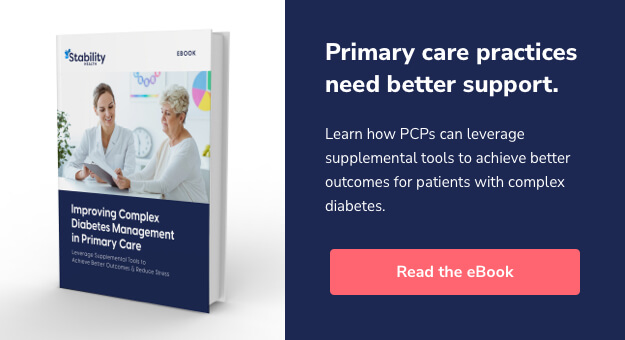
Diabetes Non-Compliance: Improving Patient Outcomes
Start by Rethinking “Non-Compliance”
Understanding Barriers to Consistent Diabetes Self-Care
Improving Patient Care Delivery Systems for Better Outcomes
Proactively Helping Patients Overcome Barriers to Adherence
Proactively Making Connections with Stability Health
Start by Rethinking “Non-Compliance”
If our goal is to improve patient outcomes, let’s start by reframing the problem. The reality of having a chronic condition is that self-care is a required constant. Like any other necessary constant in life, such as eating healthy meals or getting enough sleep, it’s not always possible for people to follow the recommended path. For patients with chronic conditions, especially diabetes, these lapses often get labeled as “diabetes non-compliance” or “insulin non-compliance.”
The concern about the use of those specific terms is that they cast shame and blame on the person with diabetes, and does not acknowledge that they are likely struggling with something that is either directly or indirectly affecting their diabetes management. Being labeled as “non-compliant” implies an intentional neglect of self-care, and that the person is willfully refusing to take the steps necessary to manage their condition.
To assist patients in improving their diabetes self-management, a more comprehensive level of support is necessary. This support starts with understanding the barriers preventing patients from managing their self-care. Instead of labeling patients as “non-compliant,” viewing them as someone grappling with an obstacle (or obstacles) can change the conversation during every appointment with their healthcare team or coach.
Changing the mindset about the failing “bad diabetic” requires clinicians to proactively provide patients with the tools and information that will help them feel more supported – that in being partially responsible for their own care, they are part of a team.
Understanding Barriers to Diabetes Self-Care
First: There are far more variables at play here than we can possibly cover in a single article. Every person has their own unique set of circumstances influenced by their underlying physical health, personal history, geographic location, economic stability, and so much more. That said, there are a few issues that stand out as consistent barriers for effective diabetes management.
Patients can lack education and understanding of their condition
There are a host of “need to know” details when it comes to effective management of diabetes: how and when to take medication, how to monitor blood sugar (glucose) levels, how to recognize changes in conditions and what actions to take. In order to truly understand how to self-manage, diabetes patients and their families require educational support about the effects of diabetes on the body and how medication, exercise, and lifestyle adjustments can counter those effects. Several studies have shown (including these published in Patient Education and Counseling, Population Health Management, and the Journal of Clinical and Applied Research and Education) that diabetes self-management education is important for improving self-care and, ultimately, patient outcomes.
Patients can have their own intrinsic barriers to adherence
A patient’s socioeconomic status, comorbidities, age, and cultural beliefs can factor into how they perceive advice for self-management or can make it more difficult to access assistance. Underlying psychological issues including anxiety, depression, and eating disorders can also compound these issues or act as barriers to adherence on their own.
It can be difficult for a clinician or care team to detect these barriers. There’s always a risk that they may overlook important background information or may not notice slight changes in mood or behavior. Everyone, especially clinicians, needs to make an effort to be sensitive to these issues when counseling patients. Understanding the patient’s perspective – especially fears or uncertainties – is the starting point for removing these barriers.
As much as possible, clinicians should communicate with a patient’s family members or healthcare proxies and encourage patients to stay in regular contact with their support networks. Educating a patient’s social circle about the benefits of treatment and self-care can help provide greater levels of social support for more consistent care.
Patients can be frustrated by the complexity of treatment
When patients think of their treatment as difficult, complicated, or burdensome, they are less likely to persist with their self-management and can be labeled as “non-compliant.” Clinicians need to ensure that patients are not experiencing adverse events related to using injectable medications, such as injection-site reactions that cause irritation or swelling. It is also important to understand if patients have any unpleasant feelings associated with medication, such as a fear of injections.
Over time, patients may begin to feel that the constant requirements of self-care are too burdensome. They may get tired of giving themselves injections or feel that they’re taking too many pills. Some patients may even have difficulty in managing multiple medications throughout a day, due to physical impairment, mental fatigue, or just being too busy.
Understanding the important benefits of treatment can counter these frustrations, while access to different treatment methods — such as the use of an insulin pen vs. vial and syringe or extended release medications — can determine how likely a patient is to adhere to their self-management. Advances in treatment options and technological assistance can help make treatment less painful, faster, and less invasive. Clinicians can ensure that patients are aware of all their available treatment options so that they can better determine the treatment regimen patients are most likely to adhere to over the long term.
Patients may feel they’re unable to afford treatment
A review of studies shows that out-of-pocket costs are an important determinant of how likely patients are to adhere to their treatment. Patients who have lower incomes are more likely to face economic barriers to consistently taking their prescribed diabetes medications. The cost of medication is also a self-reported cause of the underuse of diabetes treatment. Patients can’t be expected to easily overcome their own economic barriers, and many clinicians are ill-equipped to help patients access more affordable treatment.
Therefore, it’s important for clinicians to have access to a care team with expertise in economic assistance. The team can aid in discussing the cost of treatment and pointing patients toward lower-cost options. Informing patients about savings programs offered by pharmaceutical companies can also help reduce out-of-pocket expenses.
Improving Patient Care Delivery Systems for Better Outcomes
The patient-physician relationship is one of the most important interactions in healthcare, but it is only one part of a larger system of support. As a chronic condition, diabetes requires constant monitoring and consistent treatment. Recent literature supports the augmentation of the care team with a variety of facilitators such as health coaches, care coordinators, and diabetic educators. While these care team roles are important, improving outcomes isn’t just about adding care team roles; it’s about how each team member helps patients.
Employ a multifaceted approach
Efforts to improve care need to be multifaceted, with all members of a care team offering consistent support both remotely (if possible) and face-to-face. This requires the coordination of care across multiple specialties to ensure that no barriers are overlooked. For example, implementing and utilizing diabetes population registries within a clinic would enable the care team to reach out to patients proactively and address needs between visits. All communication needs to be patient-centric and approach care from their perspective. That understanding goes a long way towards addressing many of the smaller concerns that may impede a patient’s self-management
Provide multiple patient touchpoints
When patients have more touchpoints with their available care services and can engage on their own terms at their own convenience, then they’re more apt to feel empowered to take control of their self-management. Being able to easily access and understand lab tests or having the opportunity to work with a care team to establish a management plan and set goals can better prepare patients for their next appointment with their PCP. When patients come to their care provider feeling engaged and with specific questions to ask, the interaction can be much more productive for all.
Use supplemental support programs
Another effective step can be the use of programs that support patients between visits by reaching out to them with reminders and updates. Digital systems that have access to patient information can better assist care teams in identifying areas where patients might run into trouble, such as keeping up with prescriptions or consulting with care teams. Addressing these concerns can help patients stay on top of their self-management.
For both patients and clinicians, these methods of support for improved self-management between office visits make clinical consultations more efficient and productive, and help patients understand and adhere to best practices for care. Most importantly, developing touchpoints in a proactive manner will help to identify and prevent potentially harmful situations caused by lack of adherence.
Proactively Helping Patients Overcome Barriers to Adherence
Employing messaging that is strengths-based, collaborative, and person-centered will encourage patients to take action for their treatment without waiting for clinical visits. During visits and consultations, the clinician’s role should be to assess and understand the patient, and to offer both emotional support and clinical expertise. This approach can be supported by asking the patient questions such as:
- “What would you like to get from today’s visit?”
- “What’s hard for you?”
- “What confuses, concerns, or frightens you?”
- “What’s most important for you?”
- “How can I help you reach your goals?”
DSME standards recommend integrating behavioral strategies (such as goal setting and problem solving) alongside standard clinical educational material in order to encourage patient and clinician communication that goes beyond simple status updates. Multi-channel outreach by (and easier access to) coaches provides greater convenience for patients to ask questions and discuss matters relating to their self-management.
Ultimately, health professionals have to position the patient as the primary decision-maker and actively support the patient’s efforts to achieve their own care goals.
Proactively Making Connections with Stability Health
At Stability Health, our goal is to be there for the person with diabetes and their clinicians wherever and whenever needed. Our mission is to be part of that system of support, to help guide and encourage patients, assist clinicians with tools and resources, and set health goals together.
Here’s how Stability Health works:
- We provide a coach to help keep patients on their management plan and proactively touch base when things don’t go as planned.
- We enable our coaches to provide educational resources and guidance to patients between office visits, which keeps patients engaged and PCP workload down.
- We make actionable recommendations to the patients and the PCP to help keep the patient on track and consistent in their self-care.
Whether it’s connecting through our mobile app, over the phone, or through video conference, our technology and personal interactions help to establish that important human connection that makes proactive care possible.
To learn more about how we can help improve patient outcomes, make sure to visit our Diabetes Education resources pages.



